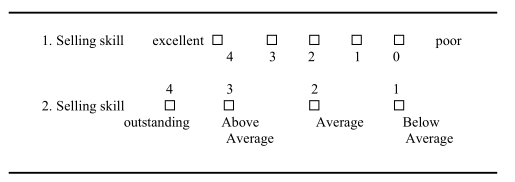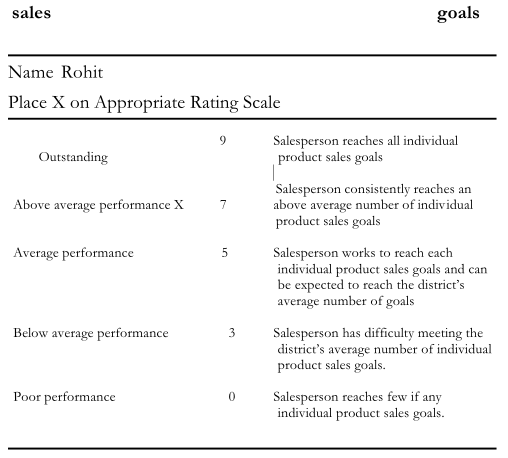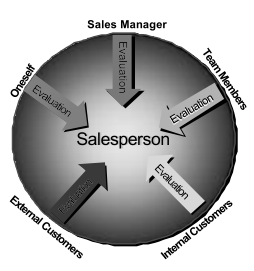Evaluating the Sales Force
The job of sales managers is not complete until the total effort of the sales force is evaluated. First, it is important to determine if the sales function is meeting its quantitative objectives. If not, the sales manager must figure out the causes. Individual salesperson performance is normally measured against sales quotas for individual sales territories, even when compensation plans do not include bonuses or commissions based on quotas. Other quantitative measures, such as number of sales calls and sales reports, may also be used in the evaluation.
Many firms also evaluate their sales force on qualitative indicators of performance such as salesperson attitude, product knowledge, and communication skills. Increasingly, as firms focus on relationship management, the level of customer satisfaction is a strong qualitative measure of superior salesperson performance.
The most difficult step in sales force control is the evaluation step-the comparing of actual performances with standards. This is more than a mechanical comparison; this step is difficult because evaluation requires judgment. The same standards cannot be applied to all sales personnel-there are differences in individual territories, their sales potentials, the impact of competition, and the personalities of sales personnel and their customers. It is possible to take territorial differences into account by setting individual performance standards for each territory, but it is not possible to adjust fully for differences in the personalities of the salesperson and the clientele. Further- more, complications often develop in relating individual performances to standards, for example, when two or more salespersons work on the same account or when an account deals both with the salesperson and the home office.
Evaluating sales personnel requires both a comparison of performance with quantitative standards and an appraisal against qualitative performance criteria. Sales personnel with poor performances, as gauged by quantitative standards, may be making offsetting qualitative contributions. Individuals who do not reach sales quotas or keep to prescribed call schedules, for instance, may be building for the future by cementing relations with distributors and dealers. Evaluating performance of sales personnel requires judgment and deep understanding of market factors and conditions.
Judgment enters into the evaluation of sales personnel in still other ways. Performance trends, as well as the current record, are relevant-an individual showing improvement but with still substandard performance needs encouragement. There is always the chance; too, that something is wrong with a standard when an individual continually fails to reach a standard, management should investigate whether the standard has been set too high.
In comparing actual results with projected results, the general procedure in scientific work is to set up tests that measure the variable under observation while taking account of the effects of other variables. In the evaluation of sales personnel it is not possible to set up such tests. Each salesperson’s performance results from complex interactions of many variables, some beyond the control of either the salesperson or of management. The time element changes and so do the sales personnel, the customers, general business conditions, competitors’ activities, and other variables. However, some companies measure the impact of particular variables on personnel performance through careful design of experimental and control groups.
Sales person’s performance evaluation approaches
- Most evaluate on an annual basis
- Most combine input and output criteria which are evaluated using quantitative and qualitative measures
- When used, performance standards or quotas are set in collaboration with salespeople
- Many assign weights to different objectives and incorporate territory data.
- Most use multiple sources of information.
- Most are conducted by the field sales manager who supervises the salesperson
- Most provide a written copy of the review and personal discussion
Performance evaluation forms: Periodically each manager is supplied with performance appraisal forms for evaluating each salesperson. Several different types of appraisal forms exists and each can have numerous variations. We will discuss some of the ways to evaluate salespersons performance.
Graphical Appraisal Scales: It is the most commonly used form for evaluating salesperson’s= performance. The manager fills out a form appraising salespersons selling skills.

The table above shows formats for such evaluation. The manager is evaluating salespersons selling skills. Two methods are shown.
Descriptive Statements: is a method of performance appraisal requiring the manager to provide a detailed, written description of each salespersons performance. Typically the manager has five to ten categories to evaluate such as selling ability, management potential, goal attainment, territorial management. The manager is usually required to use these descriptive statements to rank the salespeople.
Management by Objectives: Is a result based evaluation program. Salespeople are given objectives and their actual results are compared with the objectives to evaluate their performance
If salesperson has achieved objectives of three out of four criteria, the salesperson should explain to management why the specific product goal was not obtained and what is being done to make sure this objective will be reached in future.
Behaviorally anchored: rating scales Referred to as BARS represent an attempt to improve evaluation that use descriptive cues or adjectives. With BARS critical incidents distinguish among values on the scale. The BARS evaluation method makes each performance category easy for the manager to interpret because each includes a detailed explanation of exactly what rating means. Such evaluation methods tend to be more reliable and valid, thus reducing rating errors. Also the response categories directly represent job tasks. Thus manager can better explain evaluation to the individual involved.

The example above shows that Rohit has been evaluated as an above average in reaching company’s individual product sales goals.
360 Degree Feedback A new evaluation method which is becoming more popular among sales managers is called 360 degree feedback. Managers obtain feedback from an employee’s peers, assistants, clients and even sales manager’s supervisors in preparation for a performance review.

360-Degree Feedback System
- Salesperson is evaluated by multiple raters
- Helps salespeople better understand their ability to add value to their organization and their customers
Effective job performance is essential for organizations to stay in business and for salespeople to keep their jobs. Performance evaluations are periodically conducted with each salesperson to determine success or failure in meeting past goals and to develop plans for obtaining future goals. The primary evaluator is salesperson’s immediate supervisor.
Companies must develop performance criteria that are measurable, practical, relevant and stable. Firms use both quantitative and qualitative performance criteria. Evaluation method must effectively measure performance.
Performance evaluation serves to reward effective performers and penalize ineffective salespeople. Many difficulties can be corrected if performance evaluations are effectively conducted. The manager and salesperson must be prepared for the evaluation. Both should view evaluation positively. Performance should be honestly and openly reviewed. At the end of evaluation the manager should summarize the sales person’s past performance and together they should outline future performance objectives

